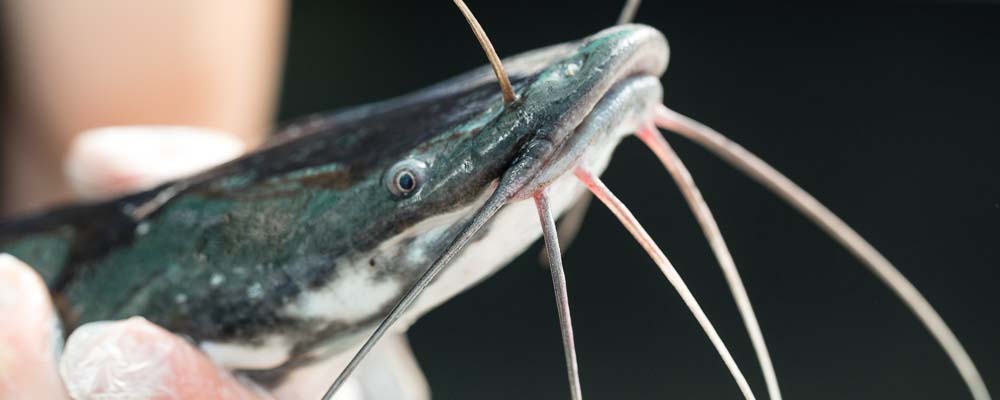Go to Cart 0,00 €
0Fresh fish – recognize, freeze & store
Fresh fish – everything you want to know
Fischers Fritz fishes fresh fish, but with our fresh fish tips, you’ll not only always catch the freshest fish when you shop, you’ll also learn how to properly freeze & store fresh fish.
“Eat fish and stay healthy” The German Nutrition Society recommends one to two servings of fish per week. Especially during winter, fish is a real vitamin D booster and can help reduce infections, colds and winter depression.
Watch out when buying fish!
We tell you which 5 characteristics you should look for when buying fresh fish to avoid unpleasant surprises.
You have the choice: Do you want to buy a fish whole or rather as a fillet?
No matter what you choose, keep these points in mind when buying fresh fish:
Surface: fresh fish has a shiny and firm surface. The slime layer on fresh fish is transparent. It becomes drier and more milky the older the fish.
Odor: Fresh fish should be almost odorless. The typical fish odor develops only when the fish has been lying for a long time. Basically, the stronger the odor, the older the fish. At the most, the fish smells pleasantly of sea, algae, lake or water, depending on where it comes from.
Eyes: The cloudier the eye, the older the fish. Fresh fish can often be identified at first glance. In fresh fish, the eyes are shiny transparent and bulging forward. If the fish is old, the eyes will appear cloudier, flatter and overall grayer.
Gills: Bright red and shiny gills are a sign of freshness in fish. If the gills are already yellow or brownish gray discolored – fingers away! If you want to buy fish whole, make sure to buy the fish with head and gills. This way you can be sure that you are buying really fresh fish.
Pressure test: Fresh fish has a firm and elastic surface. Even fresh fillet does not get dents in the pressure test. To test if the fish is fresh, simply press on the skin with your finger. If the fillet or fish returns to its original shape, it is fresh. If a pressure mark remains, you should not eat it.
STORING FRESH FISH
Fish is a perishable commodity. Therefore, you should make sure to prepare and enjoy fish quickly after buying it. Raw fresh fish should not be kept in the refrigerator for more than one day.
Tip for storing in the refrigerator: fill a glass or porcelain bowl with ice cubes and store the fish in it without packaging. The coldest zone in the refrigerator is on the back wall of the glass shelf above the vegetable crisper.
Prepared fish can be kept in the refrigerator for two days.
FREEZING FISH
You want to keep fresh fish longer? Then put it in the freezer! Frozen fresh fish can be kept for up to 4 months. Again, the smell test is the deciding factor. The older the frozen fish, the more intense the fish smell.
Freezing fresh fish is no art and quite easy, if you consider the following points:
Before freezing, you should clean the fish, wash it and remove excess water.
Pack the fresh fish airtight and use suitable containers. You do not need to use plastic, fresh fish can also be frozen in glass and paper (such as baking paper). It is important that you pack the fish as airtight as possible. Of course, vacuum packaging is the professional solution for freezing fresh fish over a longer period of time, but for short-term storage in the freezer, alternative packaging options without plastic are also suitable.
DEFROSTING FISH PROPERLY
It’s best to let frozen fish thaw slowly in the refrigerator. Half defrosted fish can be prepared as soup or casserole. Do you want to fry the fish? Then you should let it thaw completely. Pour away any condensation that has formed. Important: Never refreeze fish that has already been thawed or defrosted! Germs can form. Take the fish out of the refrigerator just before preparation and process it quickly.
If you are in a hurry, you can also defrost frozen fish quickly in a cold water bath. To do this, place the frozen fish in a freezer bag and seal it so that no water can penetrate.
Fill a sufficiently large container with cold water and put the fish in it. Note: Please do not use hot water, otherwise the fish will thaw unevenly and may become susceptible to bacteria and germs. The fish should be completely covered by the water, you can weigh it down with a plate. After about an hour, the fish should be thawed. Tip: Our fillets usually thaw faster and can be processed well.
With our fresh tips you can be sure that you always have the right nose when buying fish. If you are looking for the right recipes for fresh fish, you will always find new recipe ideas here. Have fun cooking them!

